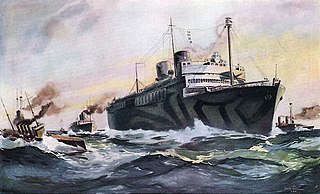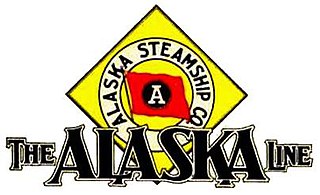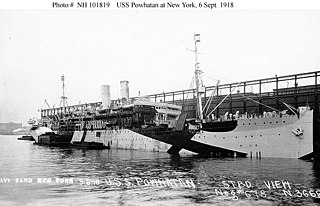Cuba is a Caribbean island country.

USS Mercy (ID-1305/AH-4) was a hospital ship in the United States Navy during World War I. She was the first U.S. Navy ship of that name. The ship was previously known as SS Saratoga, a steamer for the Ward Line on the New York to Havana route, and considered the fastest steamship in coastal trade. Before being purchased by the Navy, the ship was briefly employed as United States Army transport ship USAT Saratoga, a career that ended after a collision off Staten Island, New York.

USS Algonquin, completed as El Toro in 1891 for the Southern Pacific Railroad's Morgan Line, was a small harbor tug commissioned by the United States Navy 2 April 1898. Renamed Accomac, after Accomac, Virginia, June 1898, renamed Nottoway in 1918 and, after the Navy adopted alphanumeric hull numbers on 17 July 1920, classified as YT-18, a district tug. On 5 October 1942 the name was cancelled and the tug was simply YT-18 until 1944 when classification was changed to YTL-18, a little harbor tug. Over the years as a Navy tug, from 1898 to 1946, the tug served from Cuba to Boston.

USS Comfort (AH-3) was a hospital ship for the United States Navy in World War I. She was the sister ship of USS Mercy (AH-4) but the two ships were not of a ship class. Comfort was known as SS Havana in passenger service for the Ward Line, and as USAT Havana in United States Army service before her Navy service. Her name was restored to Havana in 1927, and she was renamed SS Yucatán in 1935, and SS Agwileon in 1941. In World War II, she was known as USAT Agwileon and USAHS Shamrock in service for the United States Army.

USS Santiago de Cuba was a side-wheel steamship acquired by the Union Navy during the first year of the American Civil War. She was outfitted as a gunboat with powerful 20-pounder rifled guns and 32-pounder cannon and was assigned to the Union blockade of the Confederate States of America. She was notably successful in this role, capturing several blockade runners. Her last major action of the war was the assault on Fort Fisher, during which seven of her crew won the Medal of Honor.

USS Siboney (ID-2999) was a ship transport for the United States Navy during World War I. She was the sister ship of USS Orizaba (ID-1536) but neither was part of a ship class. Launched as SS Oriente, she was soon renamed after Siboney, Cuba, a landing site of United States forces during the Spanish–American War. After her navy service ended, she was SS Siboney for the New York & Cuba Mail Steamship Co.. The ship was operated under charter by American Export Lines beginning in late 1940. During World War II she served the U.S. Army as transport USAT Siboney and as hospital ship USAHS Charles A. Stafford.
City of Washington was an American merchant steamship that aided in rescuing the crew of USS Maine when it exploded in the harbor of Havana, Cuba, in 1898.

SS Munargo was a commercial cargo and passenger ship built for the Munson Steamship Line by New York Shipbuilding Corp., Camden, New Jersey launched 17 September 1921. Munargo operated for the line in the New York-Bahamas-Cuba-Miami service passenger cargo trade. In June 1930 the United States and Mexican soccer teams took passage aboard Munargo from New York to Uruguay for the 1930 FIFA World Cup. The ship was acquired by the War Shipping Administration and immediately purchased by the War Department for service as a troop carrier during World War II. Shortly after acquisition the War Department transferred the ship to the U.S. Navy which commissioned the ship USS Munargo (AP-20). She operated in the Atlantic Ocean for the Navy until returned to the War Department in 1943 for conversion into the Hospital ship USAHS Thistle.
The Morse Dry Dock and Repair Company was a major late 19th/early 20th century ship repair and conversion facility located in New York City. Begun in the 1880s as a small shipsmithing business known as the Morse Iron Works, the company grew to be one of America's largest ship repair and refit facilities, at one time owning the world's largest floating dry dock.

The New York and Cuba Mail Steamship Company, commonly called the Ward Line, was a shipping company that operated from 1841 until liquidated in 1954. The line operated out of New York City's Piers 15, 16, and 17—land which later became the site of the South Street Seaport and also the Manhattan terminal of the IKEA-Red Hook ferry route. The company’s steamers linked New York City with Nassau, Havana, and Mexican Gulf ports. The company had a good reputation for safety until a series of disasters in the mid-1930s, including the SS Morro Castle disaster. Soon after, the company changed its name to the Cuba Mail Line. In 1947, the Ward Line name was restored when service was resumed after World War II, but rising fuel prices and competition from airlines caused the company to cease operation in 1954.

The Baltimore Steam Packet Company, nicknamed the Old Bay Line, was an American steamship line from 1840 to 1962 that provided overnight steamboat service on Chesapeake Bay, primarily between Baltimore, Maryland, and Norfolk, Virginia. Called a "packet" for the mail packets carried on government mail contracts, the term in the 19th century came to mean a steamer line operating on a regular, fixed daily schedule between two or more cities. When it closed in 1962 after 122 years of existence, it was the last surviving overnight steamship passenger service in the United States.

The Alaska Steamship Company was formed on August 3, 1894. While it originally set out to ship passengers and fishing products, the Alaska Steamship Company began shipping mining equipment, dog sleds, and cattle at the outbreak of the Klondike Gold Rush of 1897. The company was purchased by the Alaska Syndicate and merged with the Northwestern Steamship Company in 1909, but retained its name, and the fleet was expanded to 18 ships. During World War II, the government took over the company's ships. When the war ended, the company struggled to compete with the new Alaska Highway for passengers and freight. It discontinued passenger service altogether in 1954 and shut down operations in 1971.

USS Powhatan (ID–3013) was a transport ship for the United States Navy during World War I. She was originally the SS Hamburg, a Barbarossa-class ocean liner built in 1899 by Aktiengesellschaft Vulkan of Stettin, Germany, for the Hamburg America Line. At the outset of World War I the ship was interned by the United States.

SS Aleutian was a passenger ship in North American coastal service. Built in 1899 for the Ward Line as SS Havana, she would later serve the building of the Panama Canal as SS Panama and ultimately enter Alaskan service as SS Aleutian.
SS Haiti was a passenger and freight ship built for the Colombian Mail Steamship Company built at Newport News Shipbuilding, Newport News, Virginia and delivered 15 December 1932. The ship was renamed briefly Puerto Rico in 1938 and Monterey in 1939 to operate for the New York and Cuba Mail Steamship Company until requisitioned with transfer of title to the War Shipping Administration (WSA) on 25 September 1942. The ship was then allocated to the U.S. Army for operation under a bareboat agreement as USAT Monterey. In 1943 the ship was assigned to the command at Trinidad to supply bases in Brazil and Ascension Island. After layup in the reserve fleet the ship was sold to Turkey.

USAT Cuba was the passenger ship Cuba of the Peninsular & Occidental Steamship Company built by William Cramp & Sons Shipbuilding Company, Philadelphia in 1920 and placed into operation in 1921 for scheduled passenger and freight service between Tampa, Key West and Havana.
Josephine was an American iron-hull, sidewheel steamer that transported mail, freight, and passengers, in the Gulf of Mexico, mainly between New Orleans, Louisiana and Galveston, Texas, beginning in 1868. In 1881, the Josephine was transferred to the New Orleans – Havana route. Returning from Havana in February 1881, the Josephine encountered a winter storm in the Gulf of Mexico, south of Biloxi, Mississippi, took on water and sank, but all passengers and crew survived. In 2000, the Josephine shipwreck was listed on the National Register of Historic Places.
SS Telena was a British merchant ship that was torpedoed and sunk in the Atlantic Ocean 170 nautical miles (310 km) west north west of the Fastnet Rock by German submarine SM U-61 on 21 April 1917. Her crew survived. She was en route from Philadelphia to Queenstown, with a cargo of benzine.

Agwilines Inc was a passenger and cargo shipping company of New York City. Agwilines is short for Atlantic, Gulf & West Indies Steamship Inc. AGWI Lines group operated four main lines in the 1910s, 1920s and 1930s:

A. H. Bull Steamship Company was a shipping company and passenger liner service founded in New York City in 1902 by Archibald H. Bull (1848-1920). Service started with shipping between New York and Florida. His fleet of ships then added service to other Eastcoast ports. The company is also often called the Bull Lines and the Bull Steamship Line or A. H. Bull & Company. While founded in New York, Bull soon move its headquarter to Peir 5 in Baltimore, Maryland. Bull Lines main Eastcoast ports were: Baltimore, Charleston, Philadelphia, Tampa and Norfolk, Virginia. Oversea ports: Porto Rico, Antwerp, Bordeaux, Hamburg, Bremen, Copenhagen, and West Africa. Bull Steamship Line supported the US war effort for both World War I and World War II, including the loss of ships.



















